The Radeon R9 280X Review: Feat. Asus & XFX - Meet The Radeon 200 Series
by Ryan Smith on October 8, 2013 12:01 AM ESTOverclocking
With our look at the stock performance of our 280X cards complete, let’s take a brief look at overclocking.
When it comes to overclocking this is going to be a somewhat unfair competition for the two cards. The Asus card has by the very necessity of its existence already been binned. Furthermore while the Asus card supports voltage adjustments the XFX card does not (MSI Afterburner says it does, but adjusting the value has no effect). As such we get to drive what’s already a better GPU harder and with more voltage than the other. Still, this will give us the chance to see where everything will top out at.
| Radeon R9 280X Overclocking | ||||
| XFX Radeon R9 280X DD | Asus Radeon R9 280X DCU II TOP | |||
| Shipping Core Clock | 850MHz | 970MHz | ||
| Shipping Boost Clock | 1000MHz | 1070Mhz | ||
| Shipping Memory Clock | 6GHz | 6.4GHz | ||
| Shipping Boost Voltage | 1.2v | 1.2v | ||
| Overclock Core Clock | 880MHz | 1010MHz | ||
| Overclock Boost Clock | 1030MHz | 1110MHz | ||
| Overclock Memory Clock | 6.6GHz | 6.8GHz | ||
| Overclock Max Boost Voltage | 1.2v | 1.263v | ||
As it turns out, neither card overclocked by very much. The XFX card, lacking additional voltage, could only do 30MHz more, for a 4% base/3% boost overclock. Better luck was found on the memory with a 600MHz (10%) overclock there. The Asus card meanwhile was good for 40MHz more, for a 4% base/4% boost overclock, while its memory could do an additional 800MHz (13%). But at the same time this required dialing the voltage up to 1.263v – as high as we’re willing to go for this card. The power cost of doing that will be extreme.
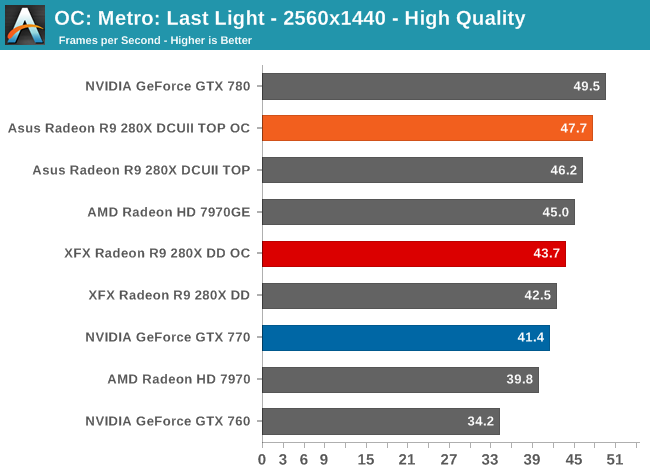
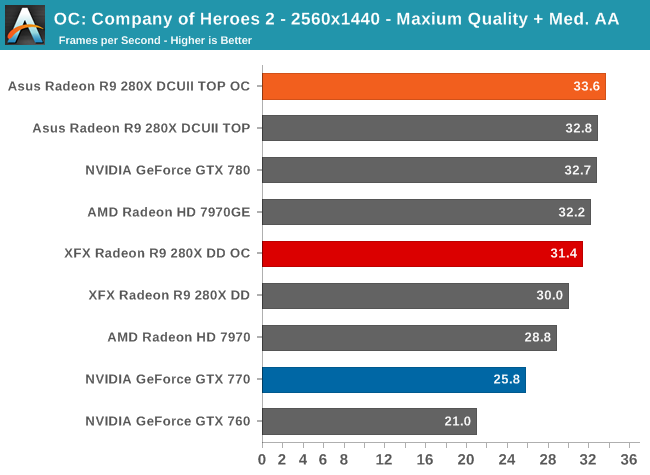
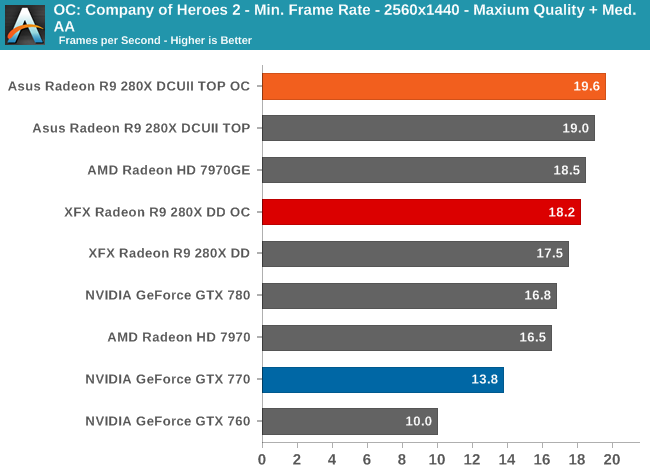
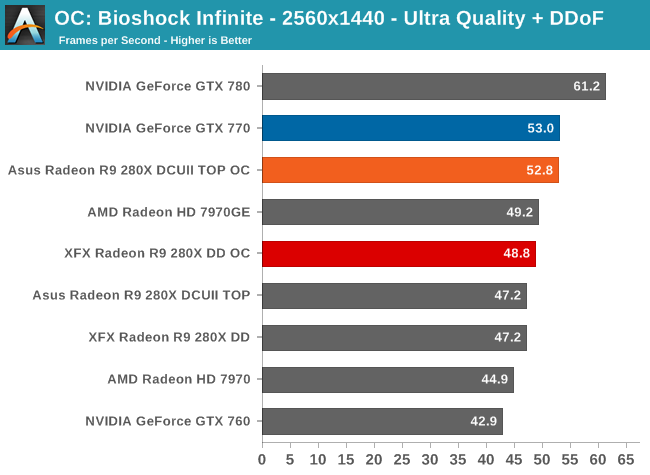
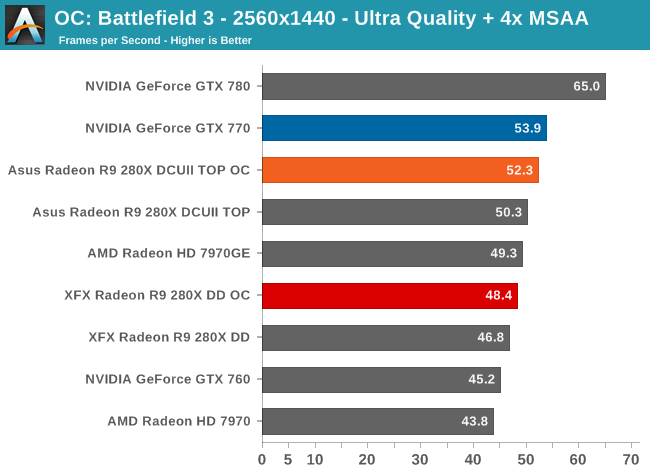
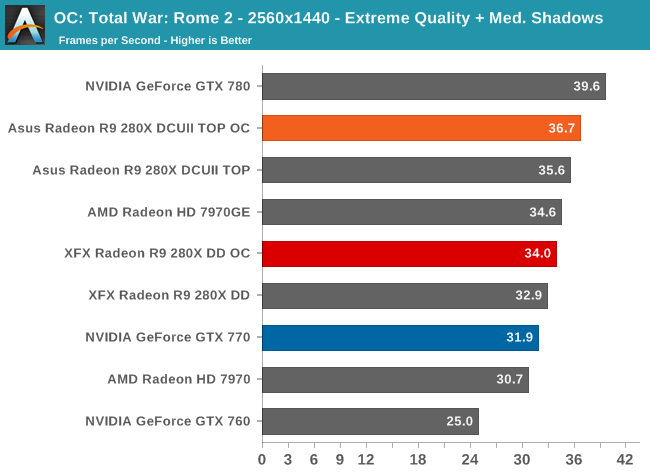
With our 280X cards primarily bottlenecked by GPU performance as opposed to memory performance, the performance gains from our overclocking adventure is limited. 3% on average for both cards is 3% for free, but it’s barely a useful overclock. We typically need 5% before overclocks start becoming interesting and significant enough to improve playability or make higher graphical settings practical.
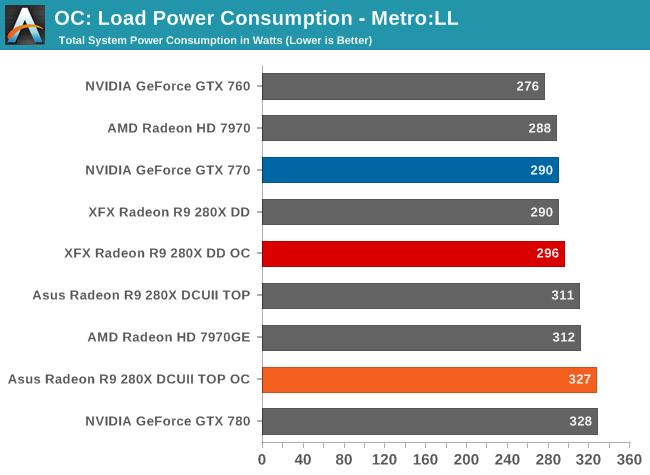
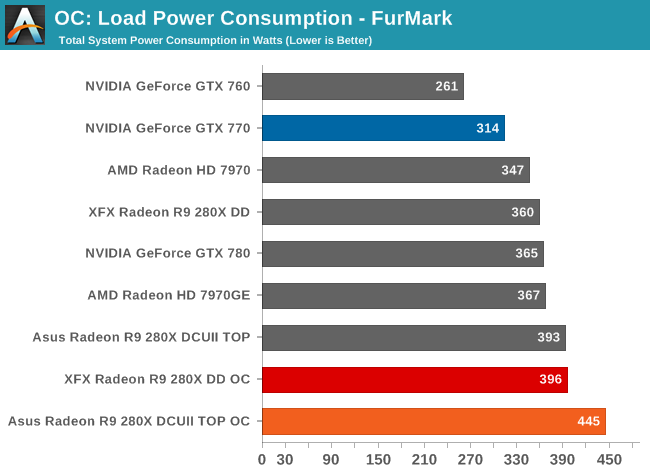
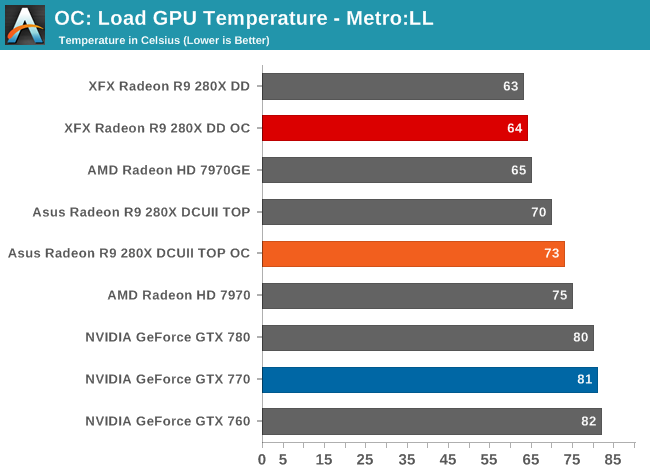
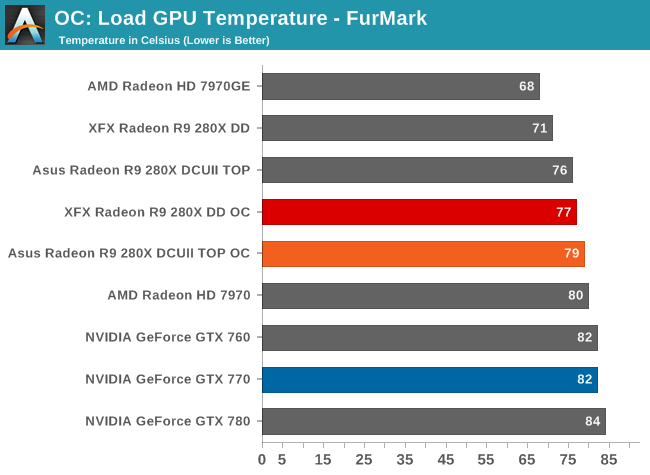
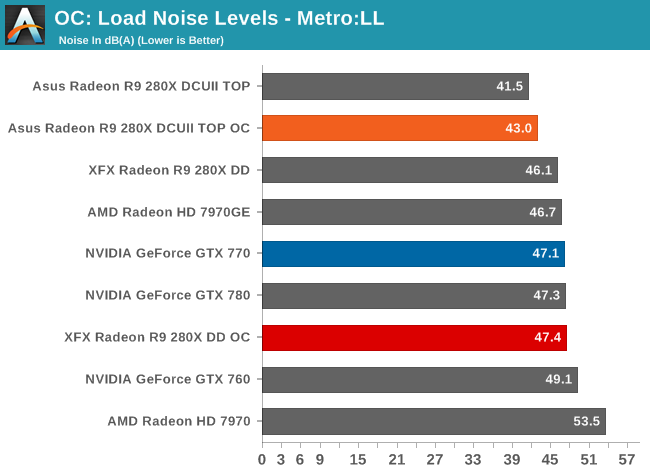
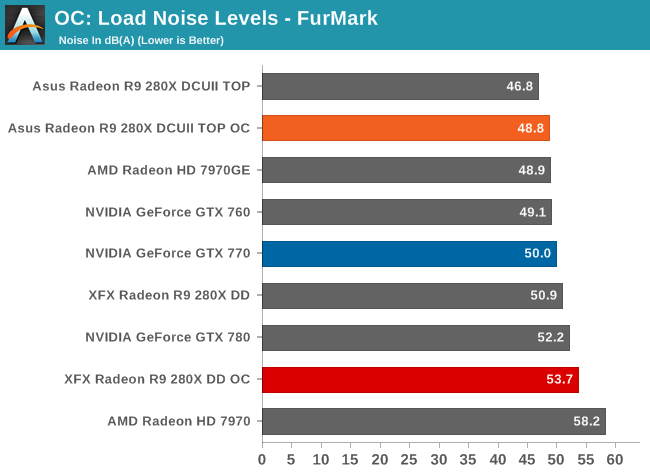
To the credit of the Asus card and its cooler, despite the increased clockspeeds, voltage, and power consumption, it’s able to keep GPU temperatures and load noise to reasonable levels given the circumstances. Still, with the increase in power required to achieve this overclock (particularly in the worst case scenario of FurMark) it’s hard to argue that the additional overclocking was worth the performance gains. With such an extensive factory overclock this is a card that may be better off left at factory clocks.
The XFX card meanwhile suffers much less of a power ramp up due to the lack of voltage control, but we’re still looking at something of a wash on the power/performance front.










151 Comments
View All Comments
Sabresiberian - Wednesday, October 9, 2013 - link
I don't think any current game dev can complain about the top API suites today when they don't even take advantage of the hardware available.Kudos to those beginning to take advantage of multiple cores in CPUs, but what you are doing clearly isn't enough. It is ridiculous that a 6-core hyperthreaded CPU doesn't provide a significant performance boost in any of today's games over a 4-core CPU without hyperthreading, and we've had them for 5 years now, so the hardware has been around longer than the development cycle of most games and should be taken advantage of by now. This is not the fault of Direct3D or OpenGL.
I'm excited about the possibilities of Mantle, but skeptical of the results. We'll see.
AnnihilatorX - Thursday, October 10, 2013 - link
On the page about TrueAudioshould it read:
Tensilica’s audio DSPs are task-specific programmable hardware, somewhere between fixed [s]function[s] and fully programmable in function,
?
Hixbot - Friday, October 11, 2013 - link
Well another gen of graphics cards and no serious change in performance per dollar. The past 2 years of PC hardware development have been BORING. Why do the big players refuse to compete seriously?fantasysportsguy - Saturday, October 12, 2013 - link
So if you have an HD 7850, what is the upgrade path?SirKronan - Sunday, October 13, 2013 - link
"Of course the fact that AMD also needs to get rid of the 7000 series at the same time isn’t going to do them any favors. There’s no getting around the fact that similar 7000 series products are going to be equal to or cheaper than 200 series products, at least for the immediate launch. "This prediction turned out to be WRONG. It is what I was expecting as well, but the opposite happened. Every 7970 on just about every store I shop at seems to have JUMPED by about $80.
What the heck??
Compuservant - Monday, October 14, 2013 - link
You do realize there is another Asus R9 280 GPU. The Asus R9 280X Matrix Platinum is their top model in this specific range and ships with a core overclock at 1,100mhz. The GDDR5 memory has also been overclocked to 1,600mhz (6.4Gbps effective).Aside from the massive overclock, Matrix R9 280X graphics cards have exclusive ROG VGA Hotwire technology built in for even more overclocking headroom. By wiring the Matrix R9 280X’s VGA Hotwire terminals to header connections on the motherboard, users are able to overvolt right away.
In conjunction with the TweakIt utility and the plus and minus buttons fitted to some ASUS ROG motherboards, VGA Hotwire puts overvolting adjustments at users’ fingertips – so they can gradually and safely increase power for higher speeds and smoother gaming. With Matrix R9 280X cards, TweakIt offers a wider voltage-modulation range than ever before and it’s also possible to immediately activate the dual 100mm fans — enabling maximum airflow and instant cooling at the touch of a button.
Most of above was cut and paste (sorry), but do you know of a supported motherboard for the i7 4770k CPU?
I think I read that the new cards can do crossfire without a bridge/connector. Imagine the performance for $650 or so, for 2 280x Matrix Platinums!
Death666Angel - Tuesday, October 15, 2013 - link
I know the article is older, but I just got to it.In the overclocking section, you write:
"The Asus card meanwhile was good for 40MHz more, for a 4% base/4% boost overclock, while its memory could do an additional 800MHz (13%)."
But it base clock is factory overclocked at 6.4GHz and it achieves a 6.8GHz clock in your test, so it is "just" a 400 MHz boost.
Dragonheart.BY - Thursday, November 14, 2013 - link
Is there any info about 280 non-x? Will it be released at all?inFormal - Wednesday, December 18, 2013 - link
I m trying to find (& order) an Asus R9 280x DCII 3GB (Tahiti XTL) but everywhere i looked they're "OUT OF STOCK" ... what the fudge ? Don t they know that i am prone to do useless it shopping during December ?dsmogor - Friday, January 24, 2014 - link
Can SteamOS access that as well (by having Mantle somewhat integrated with OGL) we would have a winninng arch/software combination.